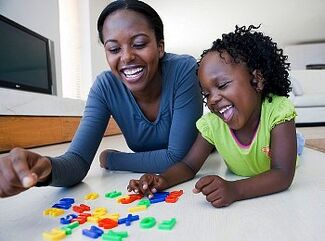
Floortime is a therapy for autistic and other disabled children. Floortime involves meeting a child at their current developmental level, and building upon a particular set of strengths. Floortime is child-focused -- the parent or therapist follows the child's lead, with playful positive attention and tuning in to the child's interests. Proponents of Floortime claim that by entering into a child’s world, support can be given to climb the "developmental ladder".
While interventions such as Applied Behavioral Analysis (ABA) have proved effective as interventions for autism spectrum disorders, new types of developmental interventions such as Floortime have emerged in response to criticisms that the rote learning involved with behavioral interventions may not result in generalized learning, and may actually impede personal and emotional development due to ethical violations.
Autistic people frequently recommend floortime as it helps parents connect with and understand their autistic children.
History of Floortime[]
Beginning in the 1980s, Stanley Greenspan built upon research into social-emotional development to create a proprietary intervention for children with deficits in relating and communicating. This method is known as Developmental Individual Difference Relationship Model (DIR Model). Floortime, which is a specific therapeutic technique also developed by Greenspan, is often confused with the DIR Model.
The basic premise of Floortime is that children learn skills from the relationships which they have with their caregivers and other people significant in their lives. It was developed in response to the needs of the increasing population diagnosed with disorders on the Autistic Spectrum, who were then being either served
Strategies used in Floortime[]
Floor time leverages things the child likes to continuously build more and more complex interactions. Child likes could include a specific toy, music, activity, etc. By focusing interaction on the items the child already has interest in more complex circles of interaction can be created. Interactive play involves the adult following the child's lead, and aims to encourage the child to "want" to relate to the outside world to get more of the things in which they are interested. Early intervention is encouraged as soon as possible as the child is likely to become more withdrawn and difficult to reach as they get older.
During the preschool program, Floortime includes integration with typically developing peers. Greenspan contends that interactive play, in which the adult follows the child's lead, will encourage the child to 'want' to relate to the outside world. Furthermore, Greenspan (1998) stipulates that the program should begin as soon as the child is identified as the longer children are uncommunicative, the more difficult parents find relating to them and the more the children withdraw. According to Greenspan (1998), intervention must transform perseveration into interaction. Once this occurs, he theorizes that the child becomes purposeful, and can imitate gestures, sounds, and play.
Six milestones of development[]
Relationships, according to Greenspan and Wieder, are essentially developed in playful interactions. Greenspan's theory of development is that children grow, from birth to 4 years, in six different milestones to succeed in further learning and development.
- Self-Regulation: The dual ability to take an interest in the sights, sounds and sensations of the world and to calm oneself down.
- Intimacy: The ability to engage in relationships with other people.
- Two-Way Communication: The ability to engage in two-way communication with gestures.
- Complex Communication: The ability to create complex gestures, to string together a series of actions into an elaborate and deliberate problem-solving experience.
- Emotional Ideas: The ability to create ideas.
- Emotional Thinking: The ability to build bridges between ideas to make them reality-based and logical.
Research into Floortime[]
Greenspan (1998) claimed that "We have worked with a number of children diagnosed with autism or PDD-NOS between the ages of 18 and 30 months who, now older, are fully communicative (using complex sentences adaptively), creative, warm, loving, and joyful".
Anecdotal evidence suggests that a number of parents find Floortime to be an effective intervention. No independent, peer-reviewed, published studies of Greenspan's DIR/Floortime's effectiveness for children with autism were identified (Roberts & Prior 2006) so Floortime would not currently be regarded as an evidence-based treatment.
